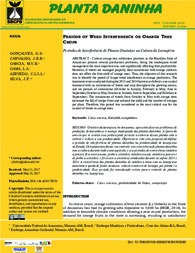Periods of weed interference on orange tree crops.
Periods of weed interference on orange tree crops.
Author(s): GONÇALVES, G. S.; CARVALHO, J. E. B. de; GARCIA, M. V. B.; GAMA, L. A.; AZEVEDO, C. L. L. L.; SILVA, J. F.
Summary: Current orange tree cultivation practices in the Brazilian State of Amazonas present several production problems, being the inadequate weed management the most important one, and significantly affecting fruit productivity. However, if weeds are managed properly, their coexistence with orange cultivars does not affect the fruit yield of orange trees. Thus, the objective of this research was to identify the period of longer weed interference in orange production. The treatments were conducted during the 2013 and 2014 harvests as follows: one control treatment with no coexistence of weeds and crop throughout the growing season; and six periods of coexistence (October to January, February to May, June to September, October to May, October to January, June to September, and February to September). The coexistence of weeds from October to May with orange trees increased the fall of unripe fruits and reduced the yield and the number of oranges per plant. Therefore, this period was considered as the most critical one for the control of weeds in orange trees
Publication year: 2018
Types of publication: Journal article
Unit: Embrapa Western Amazon
Keywords: Citrus, Competição de Variedade, Fruit yield, Fruto, Imperfect competition, Laranja, Oranges, Rendimento
Observation
Some of Embrapa's publications are published as ePub files. To read them, use or download one of the following free software options to your computer or mobile device. Android: Google Play Books; IOS: iBooks; Windows and Linux: Calibre.
Access other publications
Access the Agricultural Research Database (BDPA) to consult Embrapa's full library collection and records.
Visit Embrapa Bookstore to purchase books and other publications sold by Embrapa.

